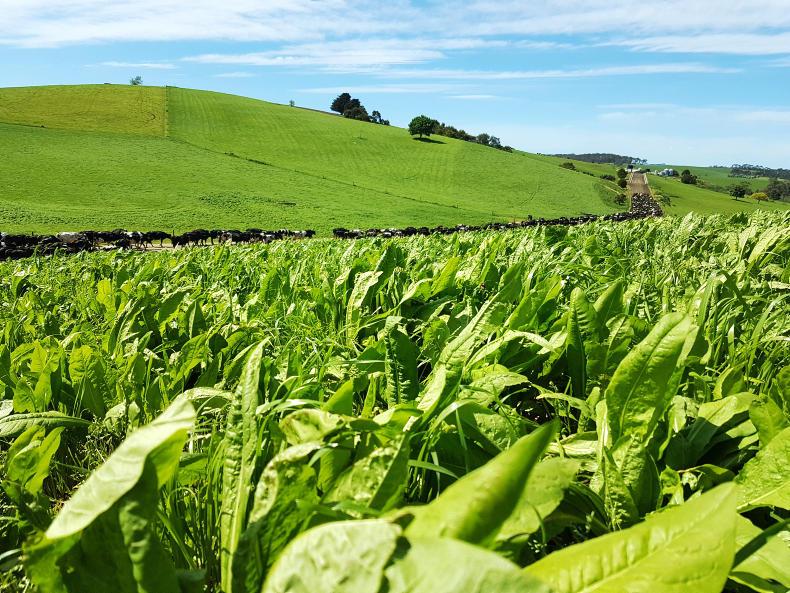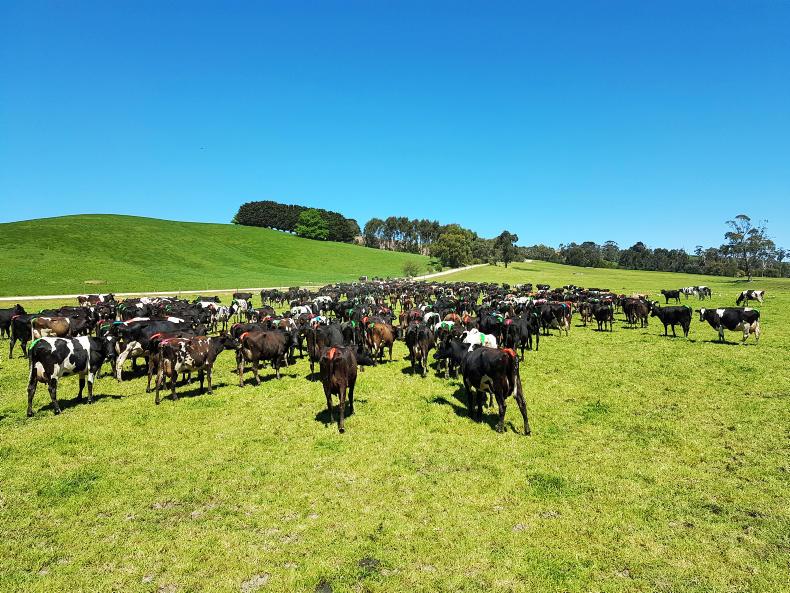As I sat at Melbourne Airport waiting for my flight home to Ireland for Christmas, I hoped security personnel would not swab my hands for fear in case they got confused by the traces of silage and tyres on my hands from the pit I had just covered.
Unlike most of Australia which has suffered from drought, the farm I manage is having one of the best seasons I have experienced in my 10 years here. Until I left in late December, the rainfall had been perfectly timed.
The silage season has been busy and long this year. We budgeted on harvesting 750kg dry matter (DM) per cow of silage but we have got almost double that so far.
Any surplus made in January will likely be made as hay or carried forward and fed as standing hay to the in-calf heifers.

Brian Corr is managing a dairy farm in Victoria, Australia, which consists of two milking platforms of 180ha each and a separate 200ha block for youngstock.
We have two farms in Gippsland, which is in the southeast of the state of Victoria.
One of the farms has a 40-bail rotary milking parlour, where we milk 450 cows once a day.
The second farm has a 60-bail parlour milking 550 cows twice a day. Both milking platforms are approximately 180ha (445ac).
We have another 200ha (494ac) with 300 R1s (heifers aged three to 10 months) and 360 R2s (heifers aged 10 to 22 months).
The cows are grazing about 50% chicory and 50% grass right now.
Around 15% to 20% of the milking platform is planted to chicory each spring to fill the summer feed gap.
Chicory has a tap root that accesses the deeper moisture that is unavailable to the grass.
Growth rates of chicory will exceed 100kg DM/day when grass has almost stopped growing due to moisture stress.
Grain feeding has been under 1kg/hd for most of this season and will likely stay that way for the remainder of the season due to the price being over $500/t.

Brian Corr is managing a dairy farm in Victoria, Australia, which consists of two milking platforms of 180ha each and a separate 200ha block for youngstock.
With hotter temperatures forecast for this month, we probably have four weeks until the silage pit will be open. Our breeding season has now ended. We completed 10 weeks of AI and put the bulls in for three weeks.
We won’t keep any of the cows that go in calf to the bulls.
These cows will be sold to farms in another district as they would be calving too late for us.
I used a progesterone-based “why wait” breeding programme, which resulted in over 80% of the herd being submitted in the first 10 days.
The majority of the AI bulls we used this year were Irish Holstein Friesan bulls from Ireland Genetics (Munster AI and Progressive Genetics).
They were used on our mainly crossbred herd, with a few Jersey bulls used on our few remaining larger Holsteins.
All bulls now being used on the herd are A2 sires, so they sire cows that naturally produce only the A2 protein and no A1 protein in their milk.

Brian Corr is managing a dairy farm in Victoria, Australia, which consists of two milking platforms of 180ha each and a separate 200ha block for youngstock.
The A2 Milk Company claims that people who experience discomfort drinking ordinary cows’ milk may experience relief when they switch to milk with predominantly A2 protein.
Using these bulls mean it may be an option for us to supply A2 milk in the future.
After a warm Christmas at home in Monaghan, I look forward to 2019 and our good fortunes hopefully continuing.
As I sat at Melbourne Airport waiting for my flight home to Ireland for Christmas, I hoped security personnel would not swab my hands for fear in case they got confused by the traces of silage and tyres on my hands from the pit I had just covered.
Unlike most of Australia which has suffered from drought, the farm I manage is having one of the best seasons I have experienced in my 10 years here. Until I left in late December, the rainfall had been perfectly timed.
The silage season has been busy and long this year. We budgeted on harvesting 750kg dry matter (DM) per cow of silage but we have got almost double that so far.
Any surplus made in January will likely be made as hay or carried forward and fed as standing hay to the in-calf heifers.

Brian Corr is managing a dairy farm in Victoria, Australia, which consists of two milking platforms of 180ha each and a separate 200ha block for youngstock.
We have two farms in Gippsland, which is in the southeast of the state of Victoria.
One of the farms has a 40-bail rotary milking parlour, where we milk 450 cows once a day.
The second farm has a 60-bail parlour milking 550 cows twice a day. Both milking platforms are approximately 180ha (445ac).
We have another 200ha (494ac) with 300 R1s (heifers aged three to 10 months) and 360 R2s (heifers aged 10 to 22 months).
The cows are grazing about 50% chicory and 50% grass right now.
Around 15% to 20% of the milking platform is planted to chicory each spring to fill the summer feed gap.
Chicory has a tap root that accesses the deeper moisture that is unavailable to the grass.
Growth rates of chicory will exceed 100kg DM/day when grass has almost stopped growing due to moisture stress.
Grain feeding has been under 1kg/hd for most of this season and will likely stay that way for the remainder of the season due to the price being over $500/t.

Brian Corr is managing a dairy farm in Victoria, Australia, which consists of two milking platforms of 180ha each and a separate 200ha block for youngstock.
With hotter temperatures forecast for this month, we probably have four weeks until the silage pit will be open. Our breeding season has now ended. We completed 10 weeks of AI and put the bulls in for three weeks.
We won’t keep any of the cows that go in calf to the bulls.
These cows will be sold to farms in another district as they would be calving too late for us.
I used a progesterone-based “why wait” breeding programme, which resulted in over 80% of the herd being submitted in the first 10 days.
The majority of the AI bulls we used this year were Irish Holstein Friesan bulls from Ireland Genetics (Munster AI and Progressive Genetics).
They were used on our mainly crossbred herd, with a few Jersey bulls used on our few remaining larger Holsteins.
All bulls now being used on the herd are A2 sires, so they sire cows that naturally produce only the A2 protein and no A1 protein in their milk.

Brian Corr is managing a dairy farm in Victoria, Australia, which consists of two milking platforms of 180ha each and a separate 200ha block for youngstock.
The A2 Milk Company claims that people who experience discomfort drinking ordinary cows’ milk may experience relief when they switch to milk with predominantly A2 protein.
Using these bulls mean it may be an option for us to supply A2 milk in the future.
After a warm Christmas at home in Monaghan, I look forward to 2019 and our good fortunes hopefully continuing.









 This is a subscriber-only article
This is a subscriber-only article













SHARING OPTIONS: